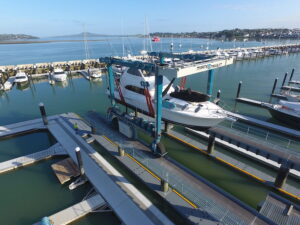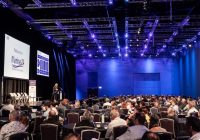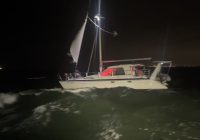Maryanne Edwards, GMBA, asked the New Zealand Marina Industries Operators Association (NZMOA) current Chairman, Chris Galbraith for an update on the current developments occurring in the NZ industry. It is nothing short of impressive when one reads the summary written by Zoe Hawkins for NZMOA which confirms that New Zealand is certainly investing heavily in the marina sector ensuring they can meet the demands from the current and future domestic market. The NZMOA is also very aware of the keen interest from the international boating market to cruise in the safe and pristine waters downunder.

The marina and boatyard industry in New Zealand is thriving. Kiwis turned to boating while the country’s borders were closed in the Covid years, celebrating the America’s Cup and investing in boats instead of travel. Added to this, boosts for marine infrastructure prioritized by the government and private investors as part of Covid recovery efforts has further lifted what was already a healthy sector pre-pandemic.
New Zealand has an expansive coastline but a relatively small population of around 5.5 million people, who own around 20,000 moored vessels at 50 marinas from the far north to the deep south.
Increasingly, like many around the world, the industry is constrained by water space and ability to expand, with strict regulations designed to protect the environment making the build of new operations challenging if not impossible.
That said, when there is a will there is a way, and new marinas are being built at Waiheke Island near Auckland and Whakatāne on the east coast of the North Island. While the boutique Waiheke facility provides much needed berthage for Auckland’s high-end fleet of recreational boats, Whakatāne and Ōhope are strategic investments that ensure infrastructure for commercial vessels and boat builders.
Demand for berthage is strong. Many marinas maintain extensive waiting lists. Therefore, rather than build new facilities, it is much more common to see marina and boatyards investing in expansions and reconfigurations. Along with this, the industry is continuously progressing its environmental performance, and finding ways to work more efficiently in order to service the maintenance needs of the growing fleet.
“Capital investment is a sure sign the sector is in good health and there has been plenty over the past 12 months, both in water and land-based developments including haulout equipment,” says Chris Galbraith, Chair of the New Zealand Marina Operators Association.

New Zealand prides itself on its environmental protection mindset. Policies and regulations can mean that marinas and boatyards have to adapt their approach to meet changing requirements: but NZMOA also considers that this is an opportunity to improve and to find new and better ways of doing things and business opportunities. Covering insurance risks and the cost of insurance is a challenge for the New Zealand industry and like our international counterparts, attracting and retaining staff, inflation, climate change and sea level rise and supply chain costs for construction are also issues that the industry is facing.
Galbraith explains: “Marinas and boatyards are like an environmental gateway to make sure the impact of vessels through biofouling, maintenance and waste discharge is minimized, and New Zealand has been particularly innovative in this area, setting benchmarks both through the Clean Marinas program and the strict environmental standards needed to construct or expand a new marina in recent years.”

Featured Projects
Northland
- Bay of Islands Marina is a relatively modern marina that was only opened by Far North Holdings 22 years ago, but it is built around one of the oldest ports in New Zealand. In fact, its 216m wharf was constructed more than 130 years ago. In 2017, a 180-berth extension was added to the marina along with a 10,000m2 land reclamation. In 2022 its 8000sqm boatyard was fully reconstructed and resurfaced, with significant operational and system system improvements that mean the operation is now a high performer in environmental terms, which is great news for a region that thrives on marine and eco-tourism.
- A new marina under the management of the Whangarei Marina team is under construction near the town basin. Okara Marina will have 114 berths ranging from 10-35m in length and will help to provide berthage for world cruisers and locally owned boats. Berths have sold quickly.
Auckland
- A significant expansion of Orams Marine Village means this specialist superyacht facility is now home to 30 marine specialist businesses on a 19,274 square metre site. The marina can accommodate boats up to 90m in length and it boasts an 820 tonne travel lift and a 600 tonne slipway.
- The publicly owned Westhaven Marina remains one of the biggest marinas in the Southern Hemisphere (if not the biggest) with more than 1,800 berths. It is nearing the end of the delivery of an extensive masterplan, a suite of projects encompassing more than 15 years. This includes converting underutilized space to modern marina berths, public space and boardwalks, a new marine village within the marina’s boundaries, a charter base, refurbishment program and more.
- Half Moon Bay is also extensively refurbished and expanded: a new North Pier features 94 berths that were all sold before construction began, bringing the total to 582 A new boatyard is serviced by an 85-tonne travel lift and offers an undercover work area for up to 24 vessels.
- An important part of the solution to Auckland’s infrastructure shortage: Tamaki Marine Park is a new entrant to the market and offers a drystack, marina and haulout in a sheltered river location. Its haul out trailers can accommodate boats up to 60 tonnes and it offers large undercover sheds.
- A new marina at Waiheke Island is under construction. Kennedy Point Marina will provide permanent berthage for approximately 180 recreational boats in fully serviced berths ranging from 10m to 25m in length.It features New Zealand’s first floating car park pontoon, designed by internationally acclaimed Swedish marina company, S F Marinas AB.
East Coast
- VesselWorks is a new operation in the Bay of Plenty Region that has been transformed through council investment to support the marine industry as part of the city’s economic strategy. The 3.4ha precinct provides 6300m2 of hardstand and can lift boats up to 350 tonnes.
- Te Råhui Herenga Waka in Whakatāne will be the first marina owned by Māori in New Zealand. It has received resource consent and is funded by government and local council as part of an economic development strategy and to support the city’s very successful boat building industry. It will provide berthage for around 70 commercial vessels, a haulout and boatyard, and a marine training school.
South Island
- The $20m Queenstown Marina opened in November with 85 berths and 85 further berths, and a suite of new commercial buildings, will be available for occupation in 2025. This marina supports nautical tourism around Lake Wakatipu on which the remote alpine town is based.
- Since it was opened by the Lyttelton Port Company (LPC) in May 2018, the 170 berth Te Ana Marina has breathed life back into Lyttelton’s west side waterfront. Set between two traditional sites, Ōhinehou and Te Ana o Huikai, Te Ana is Canterbury’s only walk-on floating marina. The marina was part of a recovery plan to assist Canterbury with recovering from two significant earthquakes, and opening up more waterfront space to the public of Christchurch.
- A masterplan is now being finalized for Nelson Marina in the top of the South Island that will enable this operation to meet the needs of the region for the future. It includes Reconfiguration of marina berths to meet excess demand for larger berth sizes and ensure the existing water space is used optimally, a promenade and public space, and potentially a new sea sports facility and dry stack.
Several regions will also receive impressive and much needed new hardstand facilities: a 560tonne lift for Oceania in Whangarei, a new 380 tonne travel lift for Whanganui Port, and a 400 tonne lift for the Port of Nelson hardstand project. These facilities will be particularly useful for the commercial fleet operating around New Zealand’s coasts.
Global Marine Business Advisors (GMBA) and its associated website www.gmba.blue are not registered legal entities. GMBA is a network of independent marine industry advisors. In all articles the opinions expressed are those of the author and does not necessarily reflect those of GMBA.
Those wishing to contact GMBA in Australia can do so through MaryAnne Edwards or call +61 412 916 036







